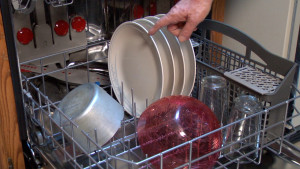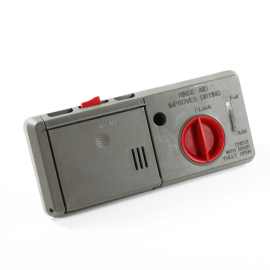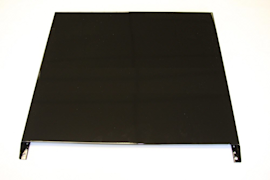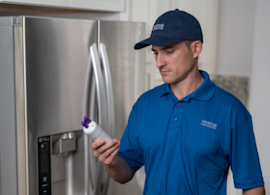- Kenmore refrigerator water filters
- Whirlpool refrigerator water filters
- Samsung refrigerator water filters
- GE refrigerator water filters
- LG refrigerator water filters
- Frigidaire refrigerator water filters
- KitchenAid refrigerator water filters
- Maytag refrigerator water filters
- Kenmore Elite refrigerator water filters
- Estate refrigerator water filters
- GE Profile refrigerator water filters
- Amana refrigerator water filters
- Bosch refrigerator water filters
- Dacor refrigerator water filters
- Electrolux refrigerator water filters
Can’t find your part? Contact us: +1-309-603-4777
Top DIY repair help
View All Repair Categories
Appliances
Lawn & Garden
Power Tools
Home Improvement
Sports & Leisure
Heating & Cooling
OrdersSchedule a repair
Keep track of the models you own in your profile
Sign in or Register to view or add models
Dishwasher not drying dishes video

This video from Sears PartsDirect shows you what to do if your dishwasher isn’t drying your dishes. There are a few things that could be causing the problem. Certain dishes like plastic items don’t dry as well as others. Other issues like water temperature and incorrect loading could also affect drying performance.
We’ll show you how to check for these simple issues before talking about some component failures. A broken heating element or a malfunctioning high-limit thermostat could also keep your dishes from drying. We’ll walk you through the whole troubleshooting process and help you get your dishwasher back in good working order.
For more dishwasher troubleshooting advice, step-by-step repair guides and error code charts, check out our Dishwasher DIY Repair page.
Tools and parts used
Cooking thermometer
Towel
Crescent wrench
Phillips screwdriver
Nut driver set
Channel-lock pliers
Torx screwdriver
Rinse aid
Multimeter
Work gloves
Rinse aid helps plastics dry
Hi, Wayne here from Sears PartsDirect. Today we're going to talk about what to do when your dishwasher isn’t drying dishes—and what you can do to fix that problem.
Dishes typically dry by the end of the dishwashing cycle, with one exception—plastic items. Because plastic doesn’t retain heat, you'll almost always see drops of water on these items after the cycle finishes. Glass, ceramic and metal dishes do retain heat from the wash and rinse cycles, and that heat helps water evaporate off the dish surfaces, even if you don’t use the heated dry option. If your non-plastic items are drying, let’s find out why.
Do you use rinse aid in your dishwasher? Rinse aid helps remove water from the surface of dishes so they dry faster. Manufacturers recommend using rinse aid even if you use detergent pods or tablets that include rinse aid, because the rinse aid dispenser in your dishwasher releases it at the right time during the cycle. Pods and tablets might not do that. So fill that rinse aid dispenser, and don't forget to refill it when it's empty or when you notice the dishes aren't drying very well.
Use heated, high-temperature settings
A heated dry setting also is an option to enhance drying. You may have this option turned off to save energy, but if your dishes aren’t drying as well, you might want to consider turning it back on. Many dishwashers also have additional options that enhance drying, such as the High Temp and Sani Rinse options. Consult your owner's manual and select the cycle options that fit your needs and your energy usage goals. How you load your dishes also affects drying performance.
Load dishes correctly
To improve drying, load dishes with enough room between them for spray to reach all areas, and make sure nothing blocks the spray arms from rotating so the spray reaches all your dishes. When you don't use the heated drying option, the dishes rely on the heat they retained in the wash and rinse cycles to help them dry. Blocking spray coverage prevents the dishes from heating so they don't dry as well. Also, tilt items with concave bottoms—like mugs and glasses—so water runs off them instead of pooling.
Check water temperature
If you’re using rinse aid and loading the dishwasher correctly, and the dishes are still wet, let’s check the water temperature. For dishes to dry without a heated dry setting, the water temperature must be at least 120 degrees. Here's how to check it: Run the sink’s hot water from your kitchen sink faucet for 1 minute and then fill a glass with the hot water. Use a cooking thermometer to measure the water temperature in the glass. If the temperature is around 120 degrees then the water supply going to your dishwasher is okay.
If it's less than 120 degrees, carefully increase the temperature settings on your water heater. Only make small, incremental increases in your water heater setting and don't set the water heater temperature above 120 degrees. This will help you avoid the risk of scalding when using the hot water in the bath or shower. Getting hot water to your dishwasher may fix your drying problem, especially if you use an air dry or no-heat dry setting to save energy.
Check the heating element
Now that we've covered the easy stuff, let’s talk about some component failures that may prevent your dishes from drying. Dishes won't dry very well if the heating element isn't working. Check the heating element for visible damage. If it's broken, replace it. Here's a video that shows you how. Sometimes, the heating element won’t work even though it physically looks okay.
Run a cycle with heated dry and see if the element heats during the drying stage. If the heating element is working, you should see steam coming up around the element or feel heat coming from it. You might even smell residue burning off the element. Don’t touch it. Those things get hot! If the element isn't heating, it could be defective even though it looks okay. It’s also possible that something else is preventing the heating element from working.
Here's how a common heating element circuit works. The electronic control board sends electrical current to activate heating in the drying mode. Current travels through the high-limit thermostat to the heating element and then back to the control board. That means a bad electronic control board, a bad high-limit thermostat or a wiring failure can prevent the heating element from working.
First, we’ll check the wiring connections on the heating element for a disconnected wire. To access the heating element and the wires, we'll need to pull the dishwasher out from under the counter. Open the dishwasher door and remove the bottom dishrack to avoid damaging interior parts when you tip the dishwasher over to examine the heating element.
Disconnect electrical power to the dishwasher by unplugging the power cord or shutting off the house circuit breaker to the dishwasher. Shut off the water supply to the dishwasher and release the drain hose from the garbage disposal or sink drain connection. Remove the bottom front access panel and toe panel and place a towel under the water line connection on the water inlet valve. Disconnect the water line and wipe up any spilled water. If the power cord plugs into an electrical outlet, position the power cord so it moves freely when you pull the dishwasher out from under the counter.
If your power cord doesn't plug into an electrical outlet, then the power cord is hard-wired into the junction box. Remove the junction box cover and disconnect the supply wires. Remove the strain relief nut to release the power cable from the junction box. Remove the screws from the mounting brackets that hold the dishwasher under the counter.
Carefully pull the dishwasher out and lay it on its back. Check the wire connections on the heating element leads and reconnect any loose wires or repair damaged wires. Reconnecting loose wires or fixing broken wires may fix your heating problem. If the wire connections are okay, test the heating element using a multimeter. Unplug the wires from the heating element leads.
Set your multimeter to measure resistance and touch one meter probe to each element lead. If the element is good, you should measure between 8 and 30 ohms of resistance. If you measure infinite resistance—that's a 1 in the far left corner on this meter—then the element is defective. If it's broken, replace it.
Check the high-limit thermostat
If the heating element is okay, check the high-limit thermostat in a similar manner. Unplug the wires from the high-limit thermostat and check resistance. You should measure near zero ohms of resistance through this component. If you measure infinite resistance, replace the high-limit thermostat.
Electronic control board failure, wiring break
If the high-limit thermostat and heating element are okay, then a defective control board or a break in the wiring elsewhere could be preventing the element from heating. We recommend you have a Sears service technician find and repair the heating system failure. The technician can perform live voltage checks—which should only be done by someone that’s properly trained.
I hope this video helped you out. You can find links to the parts we talked about in the video description. Check out our other repair videos here on the Sears PartsDirect YouTube channel. Subscribe and we’ll let you know when we post new ones.
Was this information helpful?
Most common symptoms to help you fix your dishwashers
Choose a symptom to see related dishwasher repairs.
Main causes: broken door spring, damaged or broken door hinge…
Main causes: not using rinse aid, rinse aid dispenser failure, broken heating element, malfunctioning vent, drying fan f…
Main causes: water supply problem, stuck overfill float, clogged water inlet valve screen, water inlet valve failure…
Main causes: light switch beside the sink turned off, lack of power, bad dishwasher door switch, control system failure,…
Main causes: improper loading, low water temperature, improper detergent dosage, detergent dispenser failure, spray arm …
Main causes: glass or popcorn kernel stuck in the chopper blade, drain line vibrating against the cabinet, debris in was…
Main causes: clogged kitchen sink drain, clogged drain hose, drain check valve damaged, drain pump failure, control syst…
Main cause: damaged rack height adjuster…
Main causes: damaged or stuck spray arm, leaking door seal, damaged door hinge, leaky heating element water seal, cracke…
Most common repair guides to help fix your dishwashers
These step-by-step repair guides will help you safely fix what’s broken on your dishwasher.

How to replace a dishwasher water inlet valve
If your dishwasher fills constantly or won't fill at all, the water inlet valve has failed. You can replace it in about …
Repair difficulty
Time required
30 minutes or less

How to replace a dishwasher detergent dispenser
Dishes need dish detergent to get clean. Learn how to replace a dishwasher detergent dispenser with easy step-by-step i…
Repair difficulty
Time required
30 minutes or less

How to replace a dishwasher door outer panel
If your dishwasher door is dented or you want it to match your cabinets or other appliances, this guide shows how to rep…
Repair difficulty
Time required
15 minutes or less
Effective articles & videos to help repair your dishwashers
Use the advice and tips in these articles and videos to get the most out of your dishwasher.

Get tips on completing essential holiday cleaning tasks to brighten your home.…

Learn about all the convenient features on our Sears PartsDirect website that make your parts purchases easier.…

Get answers to frequently asked questions about Sears and Sears PartsDirect.…
Parts & More
Parts
S/s Cleaner WX10X15 partsRefrigerator Pantry Drawer Guide DA97-06448B partsDryer Control Panel Assembly AGL74355301 partsIndicator DG64-00319A partsLawn & Garden Equipment Engine Screw 692125 partsRange Broil Burner 316404302 partsRefrigerator Plastic Tube WR17X11896 partsRefrigerator Evaporator W11116006 partsVent Grille WB07X20403 partsRange Hood Flue Assembly W11417192 partsWire Whip W11035281 partsRefrigerator Module DA92-00600A partsRefrigerator Dairy Bin Cover 297326200 partsCam 9703426 partsSpeed Sensor 004-6531 partsFreezer Door Gasket W10574474 partsSwitch 1752242YP partsRear Cover 4370717 partsWasher Dispenser Hose Connector DC62-00176A partsRange Warming Drawer Glide MHS61842001 parts